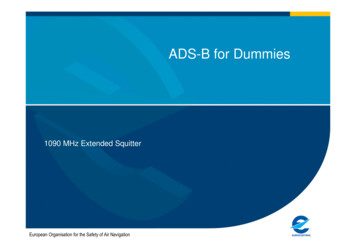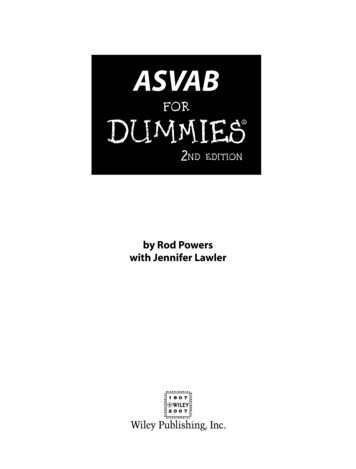
Transcription
ADS-B for Dummies1090 MHz Extended SquitterEuropean Organisation for the Safety of Air Navigation
Content Mode S overviewExtended SquitterStandardsReported ADS-B dataReception techniquesPerformance and CapacityEquipageCASCADE activities
Mode A/C SSR (ATCRBS) The SSR system ismade up of airbornetransponders andground interrogators/receiversMode A repliesconvey a target id(Code 3/A) 4096 codes allowedMode C repliesprovide thebarometric altitude
Mode S Evolutionary improvement of Mode A/C SSR. globally unique a/c identification (24 bits) selective interrogation acquisition squitter broadcastsupport for point to point datalink as well as surveillanceextension possibilities to for unambiguous data exchange with transponderssupport for the Airborne Collision and Avoidance System (ACAS) to avoid unwanted replies (“fruit”)Interrogator Codes (IC) overcoming the limitation to 4096 Code A addressesADS-B through the 1090 MHz Extended Squitter (1090ES)multilateration (surface and wide area)Backwards compatible with Mode A/C SSR (air/ground)
Mode S SignalsMode S ReplyData rate: 1 MbpsModulation: PPMPulse PositionModulation: Pulsetransmitted in the 1st or2nd half of the bitperiod (indicating a 1 or0, respectively).Mode S InterrogationData rate: 4 MbpsModulation: DPSK
Mode S Data Block
TCAS/ACAS Operation Mode Stranspondersbroadcastacquisition squittersfor identificationTCAS interrogatesnearby traffic andderives distanceand bearing fromthe repliesTCAS generatesTAs and RAs fordisplay on cockpitHMI
Mode S Acquisition Squitter The Mode S transponder outputs an unsolicited transmission once persecond to enable ACAS to acquire Mode S equipped aircraft carries only the ICAO 24 bit a/c address, which is a unique aircraftidentifier used in Mode SMODE S SHORT SQUITTER (56 BITS)8 bitCONTROL24 bitA/C ADDRESS24 bitPARITYTRANSMITTED ONCE PER SECOND
1090 MHz (Mode S) Extended Squitter1090ES includes a 56 bit data fieldused to carry ADS-B informationGNSSGNSSGNSSEXTENDED (112 BIT) SQUITTER8 bitCONTROL24 bitA/C ADDRESS56 bitADS MESSAGE24 bitPARITYEXTENDED SQUITTERGROUND STATIONADS-B information isderived from the onboardavionics navigationsystemsTO ATCFACILITY
Extended Squitter Format Preamble: Allowssynchronisation onreceptionDF Message type 11 Acq squitter17 ADS-B18 TIS-B19 MilitaryCA subtypePI error detection code
Mode S Transponder Transponders maintain avionics data in the Binary Data Store(BDS) Registers (56 bit wide).
BDS Registers BDS Registers are specified in the ICAO Manual ofMode S Specific Services and the Mode S SARPs Each register contains the data payload of a particularMode S reply or extended squitterRegisters not updated within a fixed period are clearedby the transponderRegisters are identified by a two digit hex number BDS registers are also referred to as GICB registers becausethey can be downlinked via “Ground Initiated Comm Btransactions”for example BDS 05h or BDS 0,5 is the position squitterCertain BDS registers refer specifically to 1090ES
BDS Registers for 1090ES Sixteen registers may feed 1090ES transmissions Commonly used are: BDS 05h Ext. Squitter Airborne PositionBDS 06h Ext. Squitter Surface PositionBDS 07h Ext. Squitter Status BDS 08h Ext. Squitter A/C Id & CategoryBDS 09h Ext. Squitter Airborne VelocityBDS 0Ah Extended Squitter Event ReportBDS 61h Ext. Squitter Emergency/Priority Status transmitted only in reply to interrogationtransmitted once per second during an emergencyBDS 62h Target State and Status (DO-260A only)BDS 65h Aircraft Operational Status
Position Squitter Format: Ext. squittertype (plus flags)Latitude/Longitude:Aircraft PositionCPR: CompactPosition ReportingTime: UTC time flag.Single antenna Flag:Single or dualantennasMovement: GroundspeedStatus: Validity FlagTrack: Direction ofmovementTX rate 2 /secTX rate 1/secAccuracy 5.1mAccuracy 1.2m
Velocity and Identity Squitters Subtype:Ground orairspeed flagIFR:ADS-BEquipage classA/C category:a/c (small/medium/large) orvehicle or glideror .TX rate 2 /secTX rate 0.2 /sec
1090ES Standards ICAO Mode S Ext. Squitter SARPs (Annex 10 Am. 77) Transponder MOPS EUROCAE ED-102 RTCA DO-260RTCA DO-260AAvionics Form and Fit EUROCAE ED-73B and RTCA DO-181C1090 ADS-B System MOPS defines the DF17, DF18 messagesAEEC Characteristic ARINC 718A and EUROCAE ED-86Safety regulatory standards JAA Technical Service Order TSO 2C112A for transponder ED-73AFAA TSO C112 for transponder DO-181 and TSO C166 for ADS-Bsystem DO-260/260A
DO-260 versus DO-260A DO 260A added new message “Target State and Status” (CA 29) separate accuracy and integrity indications for position replaces DO-260 intent squitter [BDS 62h]NIC/NAC/SIL instead of NUCexpanded a/c type and ADS-B reporting capabilitiesbroadcast of Mode A Codesupport for TIS-B squitter (DF18)maintaining backwards compatibilityand expanding the enhanced decoding techniquesalready defined in DO-260 [as options]
DO-260/DO-260A Change 1 Recently RTCA published Change 1 to DO-260/260A clarification of NUC calculation from GPS error signals optional broadcast of Mode A Code in DO-260 transponders squitters not used in practice [DO-260]provisions for ADS-B squitter re-broadcast was ambiguous in both DO-260 and DO-260Aremoval of “trajectory intent” and “a/c coordination” squitters useful for ADS-B report correlation with SSR dataclarification of aircraft “on ground condition” enables unambiguous indication of integrity [DO-260]useful for improving ADS-B coverageEUROCAE has not adopted Change 1 approval of ED-126 may lead to a reconsideration of the need
Target State and Status Squitter DO-260A only (BDS 62h)Numberof BitsContents5Format Type 292SubType 018Target Altitude and Flags14Target Heading/Track7NACp, NICb, SIL5Reserved2ACAS status and RA status3A/c emergency/priority status56Total
1090ES Performance Range and Capacity are the critical 1090ES performancecharacteristicsAir-air or air-ground range defines the area within which targetswill be reported with acceptable quality quality refers to accuracy, integrity, update rate Air-air or air-ground capacity refers to the maximum number oftargets that can be monitored with adequate quality within theprescribed rangeRange and capacity depend on the 1090 MHz interference(“fruit”) and decoder performance application dependent requirementsreplies to SSR/Mode S/ACAS interrogationsshort and extended squitters broadcasted from ACAS and ADS-B1090 fruit depends on civil and military SSR/Mode S interrogators Fixed ground civil surveillance infrastructureFixed and tactical military systemsaircraft traffic density and ACAS/ADS-B equipage
1090ES Range and Capacity MOPS compliant 1090ES nominal range (with low fruit 4Kmsg/sec)is 90 nmi air to air 150 nmi air to ground1090ES range drops with increasing fruit Air to air range is the most sensitive on the ground, sector antennas can reduce fruit and improve rangeenhanced decoding techniques can improve resistance to fruitThe dominant fruit today is Mode A/C replies Core Europe is the area with the highest fruit levels in the world measured in Frankfurt in 2001 at 33K replies/secFruit is expected to grow almost linearly with traffic growth unlesssignificant de-commissioning of SSR takes place
1090ES decoding techniques Squitter reception entails Preamble detectionBit and confidence declarationError detection and correctionCurrent decoding techniques are designed for narrow beam SSR andshort range ACAS operations effective only for low interference levels 4K Mode A/C msg/sec (“fruit”)can handle only one overlapping Mode A/C fruitEnhanced decoding techniques provide improvements for all 3 receptionstages and are designed to handle multiple overlapping Mode A/C fruit can handle 40K Mode A/C fruitbut do not protect better against short and long squitters
1090ES equipage Current ADS-B 1090ES avionics equipage types: ADS-B capable Mode S transponder and ACAS ADS-B capable Mode S transponder and standalone ADS-B receiver Airbus conforms to DO-260equipment is certified only on non interference basisno provision for ADSB-insuitability of ADS-B data largely depends on type/quality of GPS connectionA non transponder 1090ES ADS-B solution would befeasible but is not standardised (yet) Standalone receivers are just appearing in the marketNew Airbus/Boeing a/c come wired for ADSB-out products in the market todayhighly desirable for vehicles and non transponder equipped GA1090ES ground stations are available from a numberof vendors Mostly as part of multilateration solutionsStandards and certification procedures still in development
Summary 1090ES is an extension of the Mode S technology no new spectrum required recent Mode S transponders can be used for ADSB-out growing number of a/c squittering ADS-B but ADS-B data quality is not certifiedairborne receiver needed for ADSB-inFurther standardization work needed ADS-B application requirements must be clarifiedutility of DO-260A and Change 1 features needs to be validatedform/fit and certification standards need to be updatedstandards for ground stations must be developedRisk of eventual 1090 MHz band congestion in Core Europedepending on evolution of air traffic densityevolution of civil and military SSR/Mode S infrastructurecould be countered with more sophisticated receiver systems
CASCADE Activities on 1090ES ADS-B application requirements development Joint EUROCAE/RTCA development of standards throughthe Requirements Focus Group (RFG) ADS-B application validation on 1090ES 1090ES equipment specification development airborne and ground ADS-B systemsvalidation tools1090ES experiments and flight trials leading to updated certification standards for 1090ES equipagecontributing to ICAO standardizationOperational and technical feasibility and performance assessmentsBusiness case development for 1090ES applicationsSupport to pre-operational implementations 1090ES airborne equipage monitoring Pioneer airlines scheme Support to aircraft installation certification to ED-126Support to deployment for ADS-B 1090ES groundinfrastructures
ADS-B for Dummies 1090 MHz Extended Squitter. Content Mode S overview Extended Squitter Standards Reported ADS-B data Reception techniques . ground interrogators/ receivers Mode A replies convey a target id (Code 3/A) 4096 codes allowed Mode C replies provide the barometric altitude. Mode S Evolutionary improvement of Mode A/C SSR. globally .










